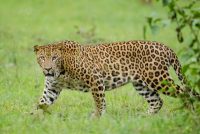The Indian leopard (Panthera pardus fusca) is one of the leopard subspecies which is found in the Indian Subcontinent. Over the past few years the leopard is quickly losing grounds to the poaching, habitat loss, and fragmentation.
The Indian leopard shares its geographic distribution with other big cats such as Asiatic lion, clouded leopard, snow leopard, and Bengal tiger.
Adult males grow 4 feet 2 inches in body length with a tail measuring at 91 cm. Males weigh 110 – 170 pounds. Females reach a body size of 3 feet 5 inches with a 2 feet 10.5 inches long tail. The average weight of a female is about 64 – 75 pounds.
Indian leopards inhabit India, Pakistan, Nepal, and Bhutan. An isolated population is thought to occur in Bangladesh too.
The Indian leopard makes home in a variety of habitats such as temperate forests, northern coniferous forests, tropical rainforests, and dry deciduous forests. The leopard will avoid living  in mangrove forests. They will share their habitats with other land predators such as leopard cats, fishing cats, golden jackals, Indian fox, and clouded leopard.
in mangrove forests. They will share their habitats with other land predators such as leopard cats, fishing cats, golden jackals, Indian fox, and clouded leopard.
Indian leopards eat axis deer, wild pig, hare, peafowl, sambar deer, common langur, and nilgai.
Indian leopards eat and move alone. They largely become active at night. Unique among its abilities is climbing. Indian leopards are excellent climbers. They will take their prey into the trees to enjoy the meal alone.
Leopards are pretty good swimmers too—perhaps not as good as tigers are! They can run at a speed of 36 miles per hour. Leopards can cover as much as 20 feet in a single stride. They can even jump 9.8 feet vertically.
Indian leopards are quite noisy. They will utter a range of sounds including meows, growls, grunts, purrs, and roars.
The home range of leopards is about 19 square miles. Females seem to have smaller range as compared to males.
The Indian leopard mates all year round. The female produces 2 – 4 cubs after a gestation period of 90 – 105 days. The birth usually occurs in a hollow tree or in a cave. Cubs are born blind and helpless.
Indian leopards can live as long as 12 – 17 years in the wild.
Humans are probably the only predators of Indian leopards.
The overall population of Indian leopards is estimated at 7,910 worldwide.





